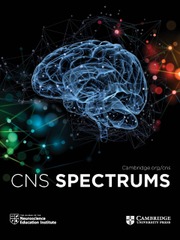Article contents
HIV-1–Associated Cognitive-Motor Disorders: A Research-Based Approach to Diagnosis and Treatment
Published online by Cambridge University Press: 07 November 2014
Abstract
The diagnosis of human immunodeficiency virus type 1 (HIV-1)–associated cognitive-motor disorder—either minor cognitive-motor disorder (MCMD) or HIV-1-associated dementia (HAD)—is fraught with potential pitfalls for the clinician. Before making such a diagnosis, clinicians should exclude other etiologies by using neuroimaging, lumbar puncture, and serum chemistries to screen for opportunistic and non-opportunistic infections of the brain and meninges. Clinicians should also consider psychoneurotoxicity (caused from the use of psychoactive substances and prescribed medications) and psychopathology, such as mood, anxiety, and other disorders. In addition, a thorough medical history and physical examination, including a complete neurologic and neuropsychiatric mental status examination, are necessary for an accurate diagnosis. There is also a need for standardized neuropsychological and functional status tests, since the diagnostic criteria for these disorders are partly based on these criteria. Treatment targets should include subclinical cognitive-motor impairment and neuroprotection, as well as MCMD and HAD. Currently, zidovudine remains the best proven treatment for these disorders, but other nucleoside reverse transcriptase inhibitors, as well as nonnucleoside reverse transcriptase inhibitors and protease inhibitors, show promise, and selected agents from these classes are being tested in clinical trials. Other areas that should be investigated are the modulation of inflammatory mediators (such as tumor necrosis factor α), neurotransmitter manipulation (especially of dopamine), and nutritional interventions.
- Type
- Grand Rounds
- Information
- CNS Spectrums , Volume 5 , Issue 8: Neuroscientific Approach to Emotions and Feelings: The Last Frontier of the New Millennium , August 2000 , pp. 49 - 60
- Copyright
- Copyright © Cambridge University Press 2000
References
REFERENCES
- 1
- Cited by


